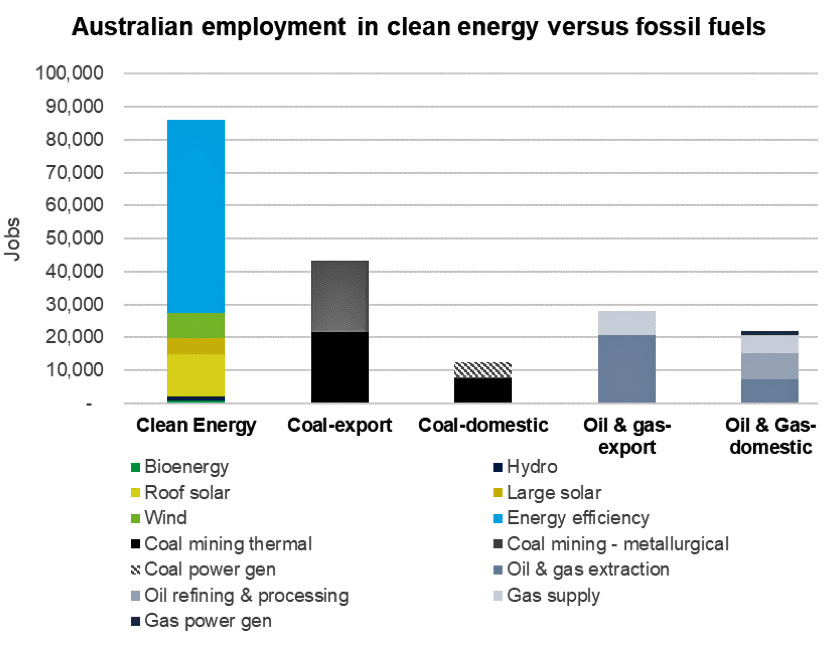Joe Biden’s election earlier this month should have been a prize opportunity for the Labor Party to put the spotlight on the inadequacies of the Morrison government’s climate policies. Instead, Joel Fitzgibbon’s resignation forced the party’s own deep divisions into the headlines. But help might be at hand from an unlikely source, in the shape of the NSW Liberal government.
Biden’s win means that just about every major advanced economy has committed to driving net emissions down to zero by 2050 (or 2060, in the case of China). Every major advanced economy except one, that is — the one led by Scott Morrison, who declares that he won’t commit to such a target without a plan for how to achieve it and an understanding of the costs.
This prompts two obvious questions. Didn’t your government sign up to the Paris climate agreement more than four years ago? And why on earth haven’t you developed a plan and carried out an economic assessment yet?
The odd thing is that it really shouldn’t be that hard for the government to commit to net zero by 2050. Morrison himself has said that net zero is “absolutely achievable” and that a 2050 deadline is “desirable.” Energy minister Angus Taylor has said the government wants to achieve net zero emissions “as soon as possible,” though he refused to commit to doing it by 2050.
But the reality is that it isn’t politically costless, at least not among his own colleagues, as the Australian Financial Review’s political columnist Phillip Coorey reminded us earlier this month. In fact, the Coalition is probably more fragile on climate change than Labor. You need only look back at what happened to Malcolm Turnbull to understand how fragile.
Fitzgibbon might point to what happened in his own seat at the last federal election to highlight the potential electoral costs of a progressive stance on climate. His seat is ground zero for thermal coalmining in Australia, and Labor suffered a negative swing of 14.2 per cent there, with most of the lost votes flowing to a coalminer representing One Nation, who managed to win 21.6 per cent of the vote. Similar results were seen in other coalmining and gas-extraction regions, in seats normally seen as marginal, across Central and North Queensland.
These swings against Labor don’t just reflect concern that emissions reduction policies would hurt employment, of course. But the fact that the Coalition chose to campaign so hard on this issue in Central and North Queensland suggests that party polling had revealed it to be an important factor.
It’s on the question of jobs that perceptions and reality have most obviously parted company. The reality is that greening Australia’s energy supplies won’t come at the expense of very many jobs in coal or gas, simply because the production of these products is primarily driven by exports. Just 24 per cent of Queensland and New South Wales’s thermal black coal production is consumed domestically, while the figure for metallurgical coal (the main product in Queensland) is a tiny 2 per cent. For gas it’s 30 per cent.
In fact, analysis by my firm, Green Energy Markets, indicates that employment in renewable energy and energy efficiency projects in 2019 significantly exceeded employment in either coal or gas. And the employment advantage in clean energy becomes overwhelming once you compare it to employment in gas and coal production intended for domestic consumption.

Sources: see below.
Australian coalminers face little threat from policies aimed at reducing Australia’s carbon emissions. Those who are employed in coal and gas power stations most certainly do, but these power stations simply don’t employ enough people to turn an election. The number of people employed in coal-fired power stations across Queensland adds up to just under 1400. For gas power stations it’s 250. If concern about emissions reduction policies really was a major factor in turning Queensland seats to One Nation and ultimately the Liberal National Party, it was because voters were made to believe that the threat to jobs from emissions reduction is far greater than it is. The Stop Adani campaign probably made an important contribution to this misunderstanding.
Those figures give a lead to those of us pushing for a fast transition to renewables. Back in January, I wrote that greater electoral support for emissions reduction would only come with a shift away from campaigns framed around stopping or shutting down polluting facilities. Crucially, emissions reduction policies need to be tied in voters’ minds to the construction of new clean energy projects, and the attendant transmission lines, that they could readily understand would create work for tradies and lower-skilled workers.
Unfortunately for economic efficiency, an emissions trading scheme doesn’t fit that bill. It’s difficult to explain why trading permits or certificates is a more effective way of reducing emissions, and better for voters’ wallets, than directly funding clean energy projects. Tony Abbott and many of his colleagues exploited this confusion to foster suspicion that emissions trading was less about the environment than about raising tax revenue.
Joel Fitzgibbon hasn’t publicly articulated a way forward for Labor that would enable the party to maintain its advantage on climate change while recognising the concerns of working people. Luckily, it’s into this void that the unlikely saviour, Gladys Berejiklian’s NSW government, has emerged. The state’s energy minister, Matt Kean, and its deputy premier, John Barilaro, have somehow worked through their differences to produce a plan that state and federal Labor parties would never have been brave enough to conceive.
The politics of climate change policy in Australia has been the story of good people trying to vainly break the nexus between energy and carbon emissions by delicately tweaking and working within the existing market-oriented structures, usually heavily guided by the incumbent industry and regulatory organisations. Instead of trying to unpick this Gordian knot, Kean and Barilaro decided they would cut straight through it with a sharp instrument. Their Electricity Infrastructure Roadmap, released this week, will supplant the existing market by setting up new government authorities to rebuild the electricity system anew, much as state governments did four decades ago.
The scale of the plan might be audacious, but it will probably strike the person in the street as plain common sense. The owners of four of the state’s five existing coal-fired power plants, representing 87 per cent of capacity, have indicated they intend to close them between now and 2035. At the same time, they say they will have trouble financing replacement plants because of regulatory uncertainty about carbon emissions. Kean and Barilaro have therefore laid out a program to remove the investment uncertainty and underwrite the construction of the renewable power plants, energy storage and power lines needed to replace the coal plants before they close.
The plan carries a real risk of creating white elephants, with electricity consumers ultimately carrying the can for any mistakes. But the risk of leaving the electricity system a prisoner of the culture wars is far greater.
Politicians opposed to climate action can hardly complain about this lurch away from markets (although the NSW proposal will uphold and support private-sector ownership). They are the ones — Tony Abbott among them — who have talked of sending in the army to seize control of privately owned power stations and nationalise them. They are the ones — Matt Canavan and Angus Taylor among them — who have proposed that governments build and own new coal- and gas-fired power stations in their preferred locations because they’re unhappy the private sector doesn’t consider them to be wise investments.
For federal Labor, the NSW plan provides a template for a national scheme that would allow it to present climate change policy as a great big construction bonanza rather than a great big tax.
Another element to this strategy can also help Labor in the Hunter and Central and North Queensland. Emissions reduction policies and technology plans do pose a real and significant threat to coal and gas workers, but they are not the plans put forward by Labor. Rather, they are the policies of governments in places like Germany, Britain, California, South Korea, China and Japan, as well as those of president Joe Biden.
According to BP’s Statistical Review of World Energy, Europe’s demand for coal is less than half of what it was back in the 1990s, while in North America it is 40 per cent lower. Renewable energy has recently overtaken coal in power generation in the United States, while in Britain it is rare for the electricity system to use any coal at all. In fact, Britain is using less coal now than it did in 1769, when James Watt patented his steam engine.
In Asia, on the other hand, demand for coal imports has been growing significantly, and this is what has underpinned the viability of Australian coalmines. For thermal coal, though, this growth has come to an end. According to the Department of Industry, Science, Energy and Resources, India, China, Japan, South Korea and Taiwan are all expected to reduce their thermal coal imports between 2020 and 2025.
Thermal coal’s future involves a steady erosion of jobs and wages as companies face a bitter battle to survive in a contracting market. With China’s economy evolving towards services, and with countries beefing up their emissions reduction efforts, metallurgical coal will confront the same fate by around 2030. Neither Labor nor the Coalition has any power to stop this.
If it remains wedded to a strategy of backing coal to the grave, the Queensland branch of the Morrison government has no help to offer these communities. The new coal power station in Townsville or Collinsville perpetually promised by the Liberal Nationals would be horribly inefficient if it needed many more than 200 people to keep it running.
Labor still has a task ahead of it to explain why the fate of coalmining does not rest with it or the Coalition. Unlike the Coalition, though, Labor can offer an alternative. Thousands of jobs would be created by a two-step program of decarbonising Australia’s electricity supply and then exporting clean energy products. The new jobs would offer opportunities to a wide array of people, but with the bulk needing either a trade-related skill or relatively modest levels of education and qualifications — in other words, the same people who currently see coalmining and minerals processing as their best opportunity for secure and well-paid employment, and who turned away from Labor at the last federal election.
All this means that if Labor chose to follow Fitzgibbon’s advice and mimic the Coalition on climate policy, it would give away what could be a great source of political advantage in Queensland. •
Sources for chart: Employment in the coal, oil and gas industries is based on the Australian Bureau of Statistics’s March 2020 Labour Market Survey. Employment in coal power generation is based on Green Energy Markets research on employment by each power plant. Renewable energy employment is derived from the Green Energy Markets database of renewable energy projects in construction and operation in conjunction with employment factors per megawatt from the University of Technology Sydney’s Institute for Sustainable Futures. Energy Efficiency Employment is taken from Green Energy Markets.




